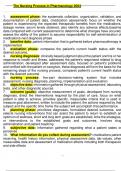The Nursing Process in Pharmacology 2024
1. assessment phase: the systematic collection, organization, validation, and
documentation of patient data, (medication assessment) focus on whether the
patient is experiencing the expected therapeutic benefits from the medications,
dosage review, serum levels obtained, also identify any adverse effects,baseline
data compared with current assessment to determine what changes have occured,
assess the ability of the patient to assume responsibility for self-administration of
medications-next diagnosis phase
2. baseline data: patient information that is gathered before pharmacotherapy is
implemented
3. evaluation phase: compares the patient's current health status with the
desired outcome,
4. nursing diagnoses: clinically based judgment about the patient and his or her
response to health and illness, addresses the patient's responsed related to drug
administration, developed after assessment data, focused on patient's problems
and verified with the patient or caregiver, these diagnoses will form the basis for the
remaining steps of the nursing process, compares patient's current health status
with the desired outcome
5. nursing process: five-part decisions-making system that includes
assessment, nursing diagnosis, planning, implementation and evaluation
6. objective data: information gathered through physical assessment, laboratory
tests, and other diagnostic sources
7. outcome (goals): objective measurement of goals, developed from nursing
diagnosis, direct the interventions required by the plan of care, focus on what
patient is able to achieve, provides specific, measurable criteria that is used to
measure goal attainment, written to include the patient, the actions required by that
subject and the specific time frame the subject will accomplish that performance
8. planning phase: prioritizes diagnoses, formulated desired outcomes, and
selects nursing interventions that can assist the patient to return to establish an
optimum of wellness, short and long term goals are established, links the strategies,
or interventions to the established goals and outcomes, involves drug
administration and patient teaching
9. subjective data: information gathered regarding what a patient states or
perceives
10. What information do you collect during assessment?: medications patient
receiving, health history information, physical assessment data, lab values, other
measurable data and assessment of medication effects including both therapeutic
and side effects
1/6
, The Nursing Process in Pharmacology 2024
11. implementation phase: involves administering the drugs, carrying out
interventions to promote a therapeutic response and minimize adverse effects of
the drug, nurse interventions- monitoring side effects, documenting medications
and patient teaching, nurse applies the knowledge, skills, and principles of nursing
care to help move the patient toward the desired goal and optimal wellness
12. Does the nursing diagnosis identify medical problems experienced by
the patient?: no
13. An appropriate stated goal for a patient with type 1 diabetes mellitus is?:
the patient will demonstrate self-injection of insuling, using a preloaded syringe, into
the subcutaneous tissue of the thigh prior to discharge
14. A 15 year old with a history of type 1 diabetes presents to the emergency
department in diabetic ketoacidosis. She has successfully self-managed her
diet and insulin therapy for the last two years. She confides in the nurse that
she deliberately skipped some of her insulin doses because she did not want
to gain weight, and she is afraid of needle marks. What nursing diagnoses is
most appropriate in this situation?: Deficient Knowledge
15. Which factor is most important for the nurses to assess when evaluating
the effectiveness of a patient's drug therapy?: Evidence of therapeutic benefit
16. Which part of the nursing process is where the nurse assesses the
effectiveness of the medication?: Evaluation
17. During the evaluation phase of drug administration, the nurse completes
what responsibilities?: Monitors the patient for therapeutic and adverse effects.
18. How long does the assessment phase last?: it is an ongoing process that
begins with the nurse's initial contact with the patient and continues with every
interaction thereafter
19. Once pharmacotherapy is initiated, ongoing assessment are conducted
to determine?: the effectiveness of the medication
20. What does the nursing diagnoses focus on?: the patients needs not the
nurses needs
21. During the diagnosis phase of pharmacotherpay what are the three main
areas of concern?: promoting therapeutic drug effects, minimizing adverse drug
effects and toxicity, maximizing the ability of the patient for self-care, including the
knowledge, skills and resources necessary for safe and effective drug
administration.
22. How is the diagnosis written?: one-two or three part statemtn depending on
whether the nurse has identified a wellness, risk or actual problem
23. What is in the third part of the diagnoses?: the evidence gathered to
support the chosen statement
2/6





